Folding and stability of the isolated Greek key domains of the long-lived human lens proteins gammaD-crystallin and gammaS-crystallin
- PMID: 17905830
- PMCID: PMC2211709
- DOI: 10.1110/ps.072970207
Folding and stability of the isolated Greek key domains of the long-lived human lens proteins gammaD-crystallin and gammaS-crystallin
Abstract
The transparency of the eye lens depends on the high solubility and stability of the lens crystallin proteins. The monomeric gamma-crystallins and oligomeric beta-crystallins have paired homologous double Greek key domains, presumably evolved through gene duplication and fusion. Prior investigation of the refolding of human gammaD-crystallin revealed that the C-terminal domain folds first and nucleates the folding of the N-terminal domain. This result suggested that the human N-terminal domain might not be able to fold on its own. We constructed and expressed polypeptide chains corresponding to the isolated N- and C-terminal domains of human gammaD-crystallin, as well as the isolated domains of human gammaS-crystallin. Both circular dichroism and fluorescence spectroscopy indicated that the isolated domains purified from Escherichia coli were folded into native-like monomers. After denaturation, the isolated domains refolded efficiently at pH 7 and 37 degrees C into native-like structures. The in vitro refolding of all four domains revealed two kinetic phases, identifying partially folded intermediates for the Greek key motifs. When subjected to thermal denaturation, the isolated N-terminal domains were less stable than the full-length proteins and less stable than the C-terminal domains, and this was confirmed in equilibrium unfolding/refolding experiments. The decrease in stability of the N-terminal domain of human gammaD-crystallin with respect to the complete protein indicated that the interdomain interface contributes of 4.2 kcal/mol to the overall stability of this very long-lived protein.
Figures
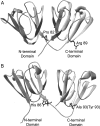

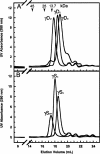

 ) γSN, and (orange
) γSN, and (orange  ) γSC.
) γSC.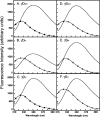

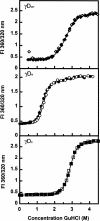
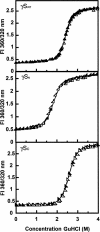


Similar articles
-
Kinetic Stability of Long-Lived Human Lens γ-Crystallins and Their Isolated Double Greek Key Domains.Biophys J. 2019 Jul 23;117(2):269-280. doi: 10.1016/j.bpj.2019.06.006. Epub 2019 Jun 14. Biophys J. 2019. PMID: 31266635 Free PMC article.
-
Contributions of aromatic pairs to the folding and stability of long-lived human γD-crystallin.Protein Sci. 2011 Mar;20(3):513-28. doi: 10.1002/pro.583. Protein Sci. 2011. PMID: 21432932 Free PMC article.
-
Partially folded aggregation intermediates of human gammaD-, gammaC-, and gammaS-crystallin are recognized and bound by human alphaB-crystallin chaperone.J Mol Biol. 2010 Aug 6;401(1):134-52. doi: 10.1016/j.jmb.2010.05.067. Epub 2010 Jun 1. J Mol Biol. 2010. PMID: 20621668 Free PMC article.
-
Gamma crystallins of the human eye lens.Biochim Biophys Acta. 2016 Jan;1860(1 Pt B):333-43. doi: 10.1016/j.bbagen.2015.06.007. Epub 2015 Jun 25. Biochim Biophys Acta. 2016. PMID: 26116913 Review.
-
Chemical Properties Determine Solubility and Stability in βγ-Crystallins of the Eye Lens.Chembiochem. 2021 Apr 16;22(8):1329-1346. doi: 10.1002/cbic.202000739. Epub 2021 Feb 10. Chembiochem. 2021. PMID: 33569867 Free PMC article. Review.
Cited by
-
Cumulative deamidations of the major lens protein γS-crystallin increase its aggregation during unfolding and oxidation.Protein Sci. 2020 Sep;29(9):1945-1963. doi: 10.1002/pro.3915. Protein Sci. 2020. PMID: 32697405 Free PMC article.
-
Amyloid fiber formation in human γD-Crystallin induced by UV-B photodamage.Biochemistry. 2013 Sep 10;52(36):6169-81. doi: 10.1021/bi4008353. Epub 2013 Aug 29. Biochemistry. 2013. PMID: 23957864 Free PMC article.
-
The G18V CRYGS mutation associated with human cataracts increases gammaS-crystallin sensitivity to thermal and chemical stress.Biochemistry. 2009 Aug 4;48(30):7334-41. doi: 10.1021/bi900467a. Biochemistry. 2009. PMID: 19558189 Free PMC article.
-
Structure and dynamics of the fish eye lens protein, γM7-crystallin.Biochemistry. 2013 May 21;52(20):3579-87. doi: 10.1021/bi400151c. Epub 2013 May 8. Biochemistry. 2013. PMID: 23597261 Free PMC article.
-
Dynamic disulfide exchange in a crystallin protein in the human eye lens promotes cataract-associated aggregation.J Biol Chem. 2018 Nov 16;293(46):17997-18009. doi: 10.1074/jbc.RA118.004551. Epub 2018 Sep 21. J Biol Chem. 2018. PMID: 30242128 Free PMC article.
References
-
- Aarts H.J., Lubsen, N.H., and Schoenmakers, J.G. 1989. Crystallin gene expression during rat lens development. Eur. J. Biochem. 183: 31–36. - PubMed
-
- Bagby S., Go, S., Inouye, S., Ikura, M., and Chakrabartty, A. 1998. Equilibrium folding intermediates of a Greek key β-barrel protein. J. Mol. Biol. 276: 669–681. - PubMed
-
- Basak A., Bateman, O., Slingsby, C., Pande, A., Asherie, N., Ogun, O., Benedek, G.B., and Pande, J. 2003. High-resolution X-ray crystal structures of human γD crystallin (1.25 Å) and the R58H mutant (1.15 Å) associated with aculeiform cataract. J. Mol. Biol. 328: 1137–1147. - PubMed
-
- Bateman O.A., Lubsen, N.H., and Slingsby, C. 2001. Association behaviour of human βB1-crystallin and its truncated forms. Exp. Eye Res. 73: 321–331. - PubMed
-
- Bateman O.A., Sarra, R., van Genesen, S.T., Kappe, G., Lubsen, N.H., and Slingsby, C. 2003. The stability of human acidic β-crystallin oligomers and hetero-oligomers. Exp. Eye Res. 77: 409–422. - PubMed
Publication types
MeSH terms
Substances
Grants and funding
LinkOut - more resources
Full Text Sources

